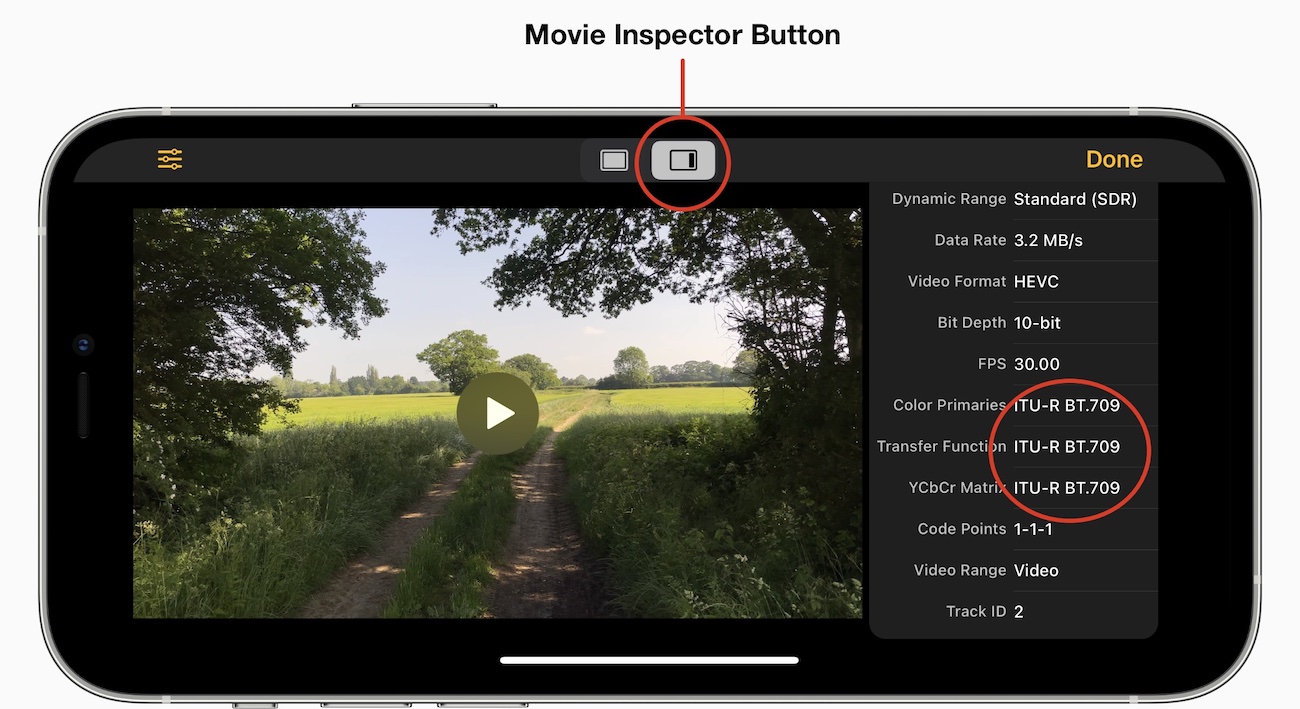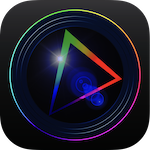Technical Guide
Cinema P3 Camera Video Formats
Cinema P3 Pro Camera is a professional camera App for iPhone and iPad.
A key benefit that Cinema P3 Pro Camera offers is the ability to capture video in formats not available in the standard Camera App. For example, formats that can capture video with a wider color palette and greater contrast ratio than standard video.
This document explains some of the characteristics of the formats, and highlights key differences in color space and contrast ratio for SDR and HDR formats.
SDR Video Formats
BT.709
The default video format used to record video on iPhones (except iPhone 12 models) is an SDR (Standard Dynamic Range) video format which follows the BT.709 standard.
BT.709 describes characteristics such as the color space and transfer function used to encode luminance (brightness) information in a video file.
The transfer function characteristics defined in BT.709 were originally developed to match the characteristics of CRT (Cathode Ray Tube) displays which were in common use at the time. Typically, these had a contrast ratio of 1000:1, or luminance range from 0.1 to maximum of 100 cd/m².
For video encoded using the default 8-bit video range BT.709 transfer function, luminance values can be stored with a contrast ratio of 985:1. Contrast ratio is the ratio of the smallest to largest linear light value that can be stored.
BT.709 recording is available in the Cinema P3 Camera App by selecting the video format option “709”.
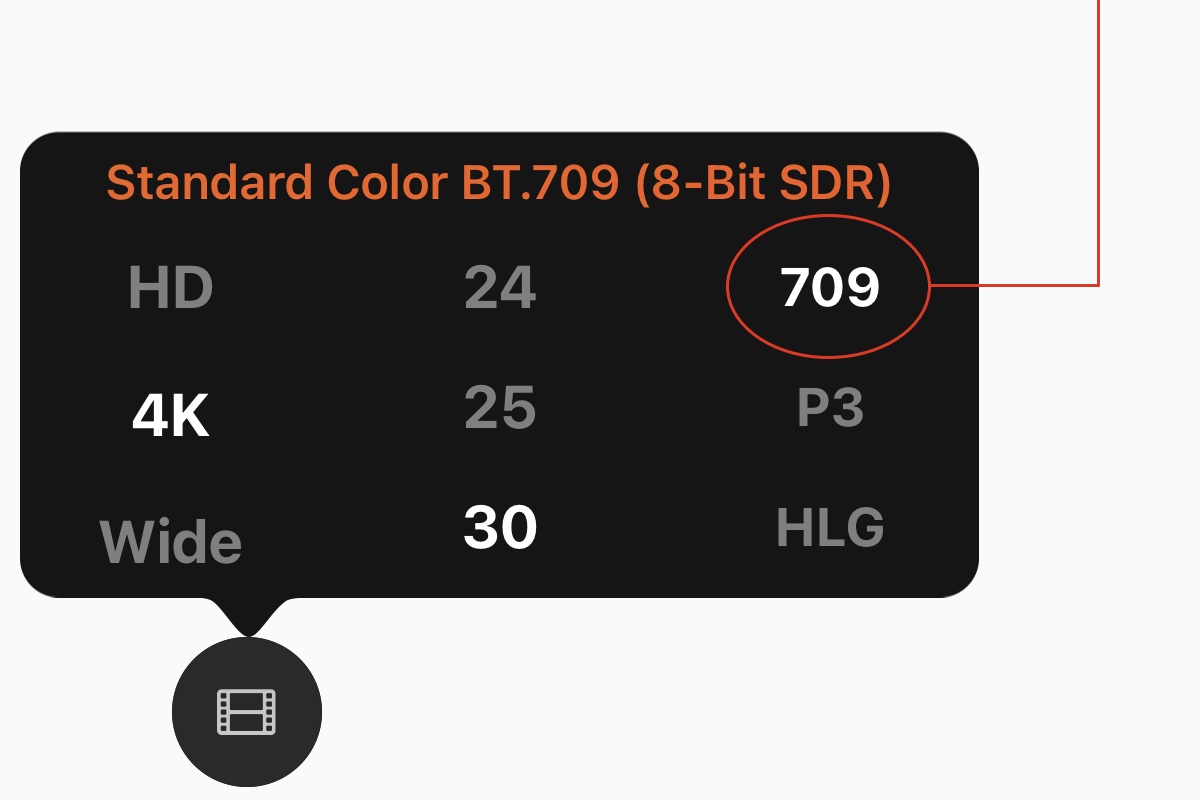
P3
Many iPhone and iPad models are fitted with wide colour displays that use the P3 color space, and can display 25% more colors than sRGB/BT.709.
The Cinema P3 Camera App enables the ability to record video in the P3 color space. This means bright and highly saturated colors can be recorded and displayed more accurately. It also records full range video which stores 15% more luma and chroma information and enables a contrast ratio of 1147:1.
P3 recording is available in the Cinema P3 Camera App by selecting the video format option “P3”. The P3 video option is an SDR format as it uses the BT.709 transfer function to encode luminance.

10-bit 709
The “10-bit 709” format is available on iPhone 12 devices and captures 10-bit SDR video in the BT.709 color space. 10-bit recording enables luminance values to be stored with a contrast ratio of 3942:1.
10-bit 709 recording is available in the Cinema P3 Camera App by selecting the video format option “709 10-bit”.

Extended Dynamic Range and Video HDR
Some iPhone models support a functionality that Apple refer to as “Extended Dynamic Range” or “Video HDR”. It was first introduced in the iPhone XS model in 2018.
Within the Cinema P3 Camera App, video HDR/Extended Dynamic Range video can be enabled using the “HDR” switch on the Camera Settings screen. The “HDR” switch is only displayed if it is supported by the selected camera and video format (color space, resolution and frame rate).
Extended Dynamic Range video increases the dynamic range of the camera by capturing two images (standard and short exposure) for each frame. These are then blended together to recover clipped highlights. It’s effectiveness depends on the type of scene being captured. e.g. it does not work so well in low light.
“Extended Dynamic Range” or “Video HDR” relates to the method used to process images received from the camera. The actual dynamic range (or contrast ratio) stored in the video file is determined by the transfer function used to encode it. When video is stored using the BT.709 transfer function (SDR video), any high dynamic range obtained from the camera is compressed using tone mapping.
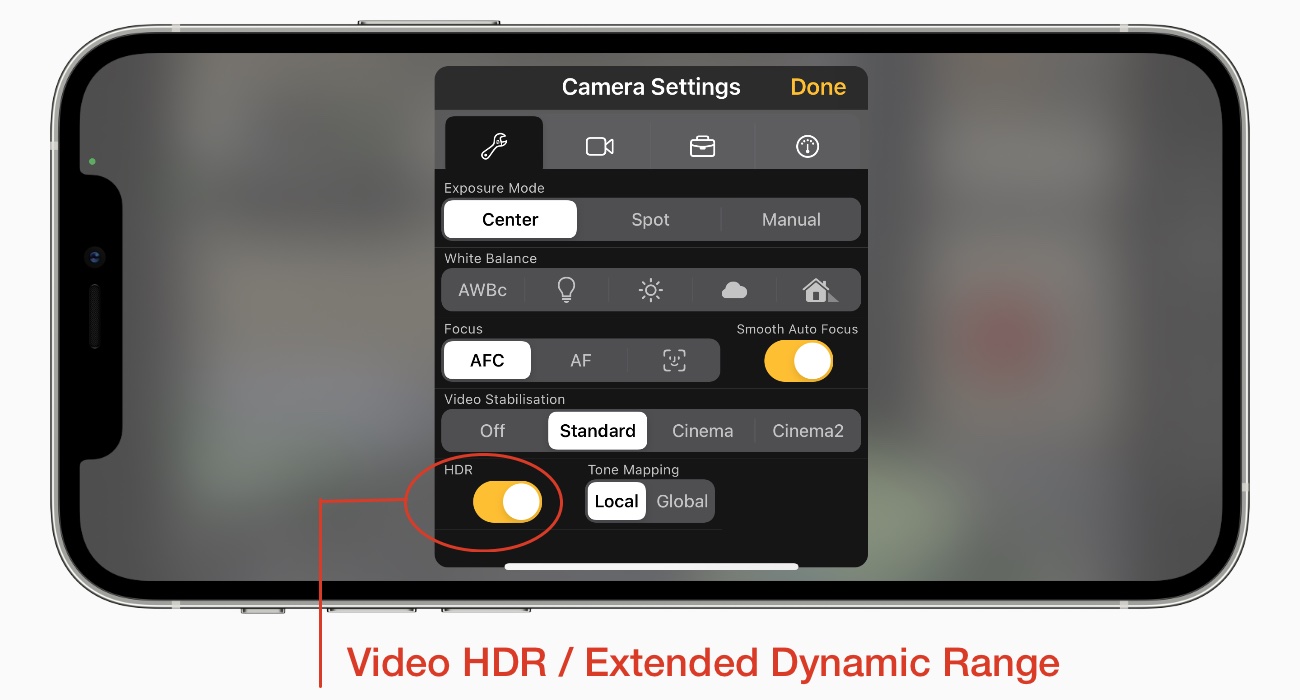
HDR Video Formats
What is HDR Video?
High dynamic range (HDR) video is about reproducing image realism and getting closer to how we view images with our eyes. It means more colors and contrast between the brightest whites and the darkest blacks compared to SDR video.
HDR video comprises technical characteristics such as higher peak brightness and lower black levels, a wider color palette, new transfer functions and greater bit depth.
8-bit HLG
The Cinema P3 Camera App enables the encoding of HDR video that retains more of the dynamic range obtained from the camera compared to BT.709 video after encoding in the video file.
It achieves this by performing additional image processing to encode the video using a transfer function known as Hybrid Log Gamma (HLG). This enables a contrast ratio of approx 196,000:1 to be encoded for 8-bit video, which is a 200x increase compared to BT.709. It also encodes video using the P3 color space which is able to store 25% more color than BT.709 video.
HDR recording is available in the Cinema P3 Camera App by selecting the video format option “HLG”.
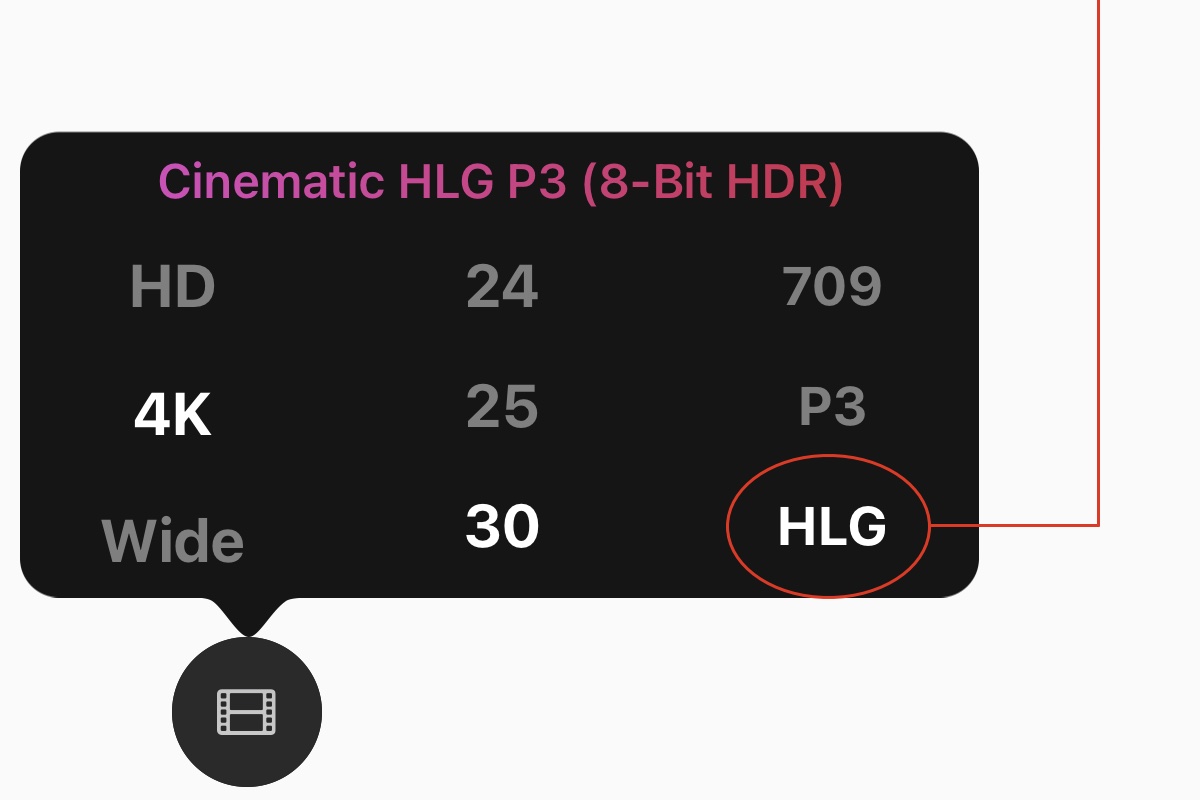
While it is posssible to capture and play back HDR video using the P3 HLG format, it should be noted that color banding may be visible in the image due to fact that it is encoded using 8-bits. 10-bit encoding is required for HDR video to minimise visible banding caused by quantising.
10-bit HLG
Apple introduced the iPhone 12 Pro in 2020 with Dolby Vision HDR video recording. This is a 10-bit video format that encodes video with the HLG transfer function in the BT.2020 color space.
Dolby Vision HDR recording is available in the Cinema P3 Camera App on iPhone 12 devices by selecting the “HLG 10-bit” video format.
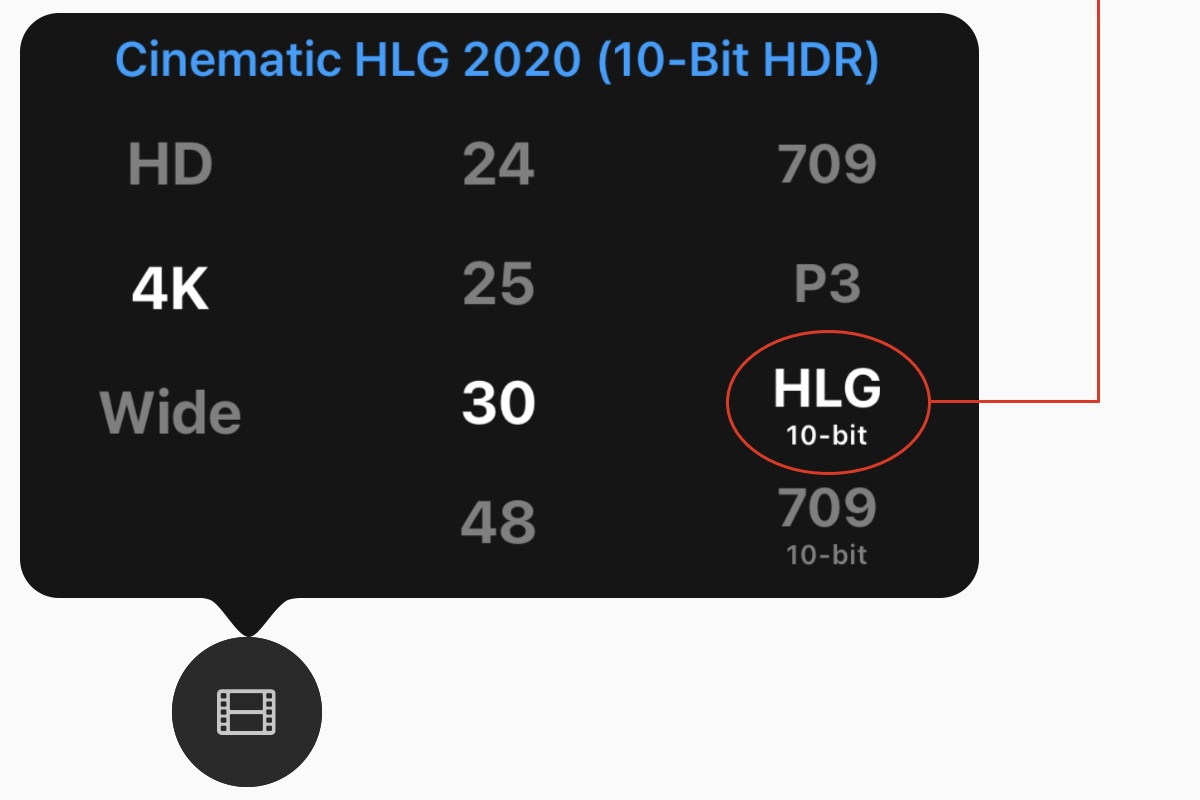
For 10-bit HLG video, a contrast ratio of approx 3,145,000:1 can be encoded.
When using the “HLG 10-bit” video format in the Cinema P3 Camera App, the “HDR” switch on the Camera Settings screen is not displayed. This is because the Extended Dynamic Range video setting for the camera is always enabled for 10-bit HLG video.
(Note that iPhone 12 devices support both 10-bit and 8-bit HLG encoding, and the description includes the subtitle "8-bit" or "10-bit" to indicate the type of encoding in use.)
Displays for HDR Video
There is no definition of the minimum contrast ratio for HDR displays, except that it should be greater that what is typically considered SDR.
In Apple Product Specifications, the display is identified as “HDR display” if it has a contrast ratio of at least 1,000,000:1. This covers iPhones fitted with OLED screens (also identified as Super Retina HD, Super Retina XDR) and the 2021 12.9” iPad Pro fitted with the Liquid Retina XDR display.
The iPhone XS for example, has an OLED display has a contrast ratio of 1,000,000:1 and a maximum display brightness of 625 cd/m². This means that it can display light values ranging from 0.000625 to 625 cd/m².
The iPhone 12 Pro has an OLED display with a contrast ratio of 2,000,000:1 and a maximum brightness of 1200 cd/m² (when displaying video content). This means that that the iPhone 12 Pro can display video content with light values ranging from 0.0006 to 1200 cd/m².
Apple products fitted with LCD displays (usually identified as Liquid Retina HD Display) have a contrast ratio of 1,400:1 and are not identified as HDR in Apple Product Specifications.
An iPhone with LCD display having a contrast ratio of 1,400:1 and a maximum display brightness of 625 cd/m² would be able to display brightness values within the range 0.5 cd/m² (black) to 625 cd/m² (white). This is suitable for displaying SDR video, but not for HDR encoded video.
The DisplayHDR open standard from VESA for HDR monitors, defines a display as being HDR if it has a contrast ratio of at least 4000:1.
Viewing HDR Video
OLED displays provide the best demonstration of HDR content as each pixel is individually illuminated enabling a very high contrast ratio to be achieved. When turned off, they produce no light (completely black) and can be illuminated from very low levels to maximum brightness.
LCD displays use a backlight to illuminate the pixels, making it difficult to display dark pixels next to very bright pixels. The backlight limits the minimum brightness that can be achieved and results in reduced contrast ratio.
When video encoded with HLG is played back on iPhones with OLED displays, it is recognised as HDR content and displayed with the increased contrast ratio stored in the video file, making full use of the display capabilities that OLED offers. It means darker shadows and greater contrast between shadows and highlights.
Some HDR displays fitted to Apple Products specify two display brightness values. For example, the iPhone 11 Pro defines 800 cd/m² max brightness (typical) and 1200 cd/m² max brightness (HDR). The higher value 1200 cd/m² is only available when playing HDR video content, and would be used to display the very brightest parts of an image such as specular highlights.
Quicktime Movie Inspector
The QuickTime Player can display information about a movie file, such as the HDR format, aspect ratio, compression format, bit depth, size, and frame rate (fps).
Open a movie file in the QuickTime Player app on your Mac.
Choose Window > Show Movie Inspector, or press Command-I to display the Movie Inspector.
The screenshot below shows the 'Video Details' section of the Movie Inspector, which contains information about the Colour Primaries and Transfer Function used to encode the video file.
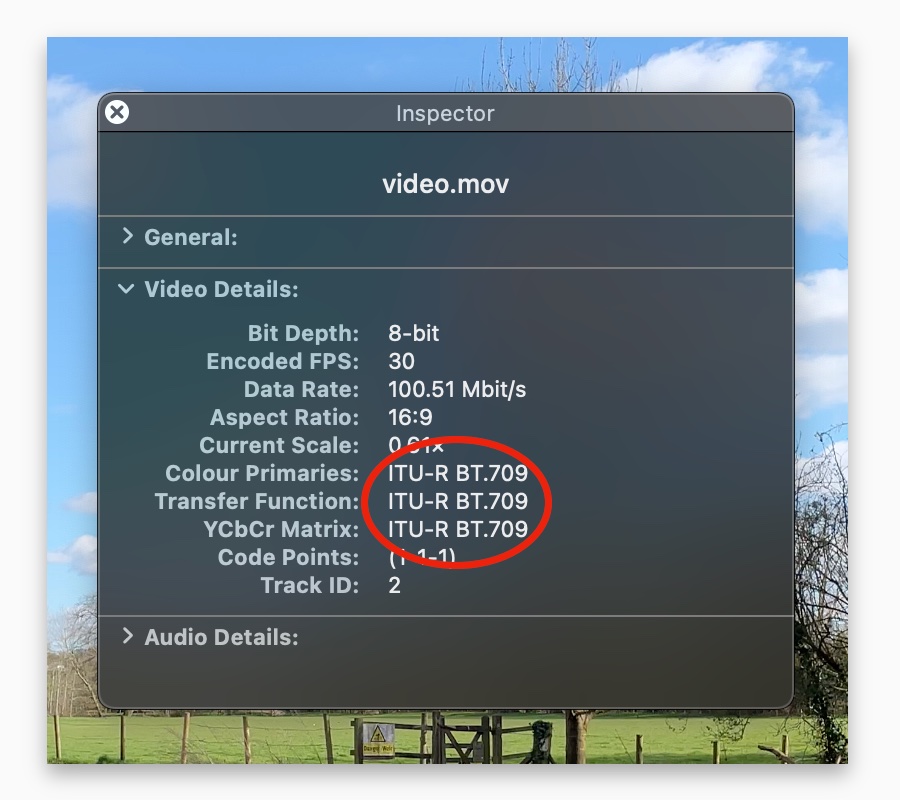
Cinema P3 Camera Movie Inspector
The properties of a video can be viewed in the Cinema P3 Camera App using the Movie Inspector.
Tap the Movie Inspector Button to display the Movie Inspector. The Movie Inspector is displayed on the right of the screen.
